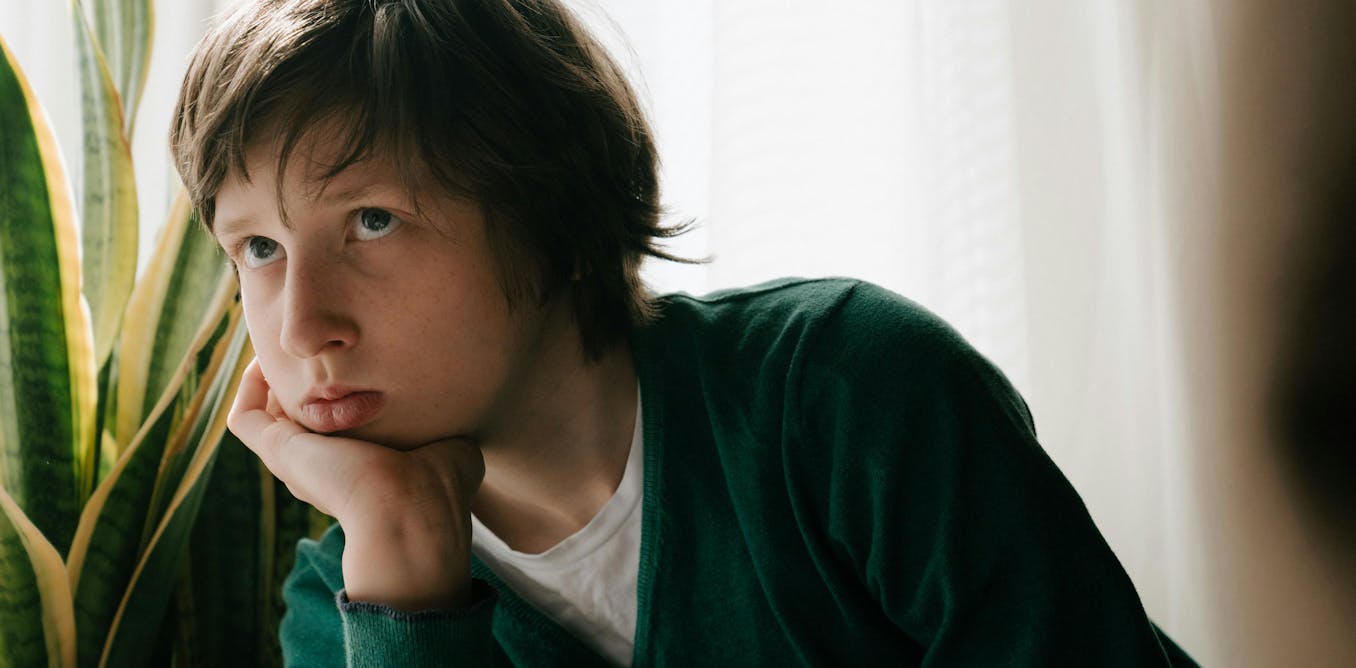A sea of tweens and teens (with a few parents in tow) covered every inch of Chicago’s Aragon Ballroom on Nov. 17. Those closest to the stage had stood outside for hours, braving the rapidly dropping temperatures of a typical Midwest fall day as they waited in an entry line that circled around the block. They were there for a therapy session with Ivan Cornejo, the 19-year-old Mexican American artist who has become the unofficial therapist for a generation, providing a healing space at his shows with songs about love and heartbreak. Cornejo, who is soft-spoken and considerably shy, looked the part of a therapist clad in gray slacks, a dark dressy shirt and a piece of fabric wrapped around like a headband that has become part of his signature onstage look.
That night was his second sold-out show at the Aragon as part of his U.S. Terapia Tour, and it was indeed therapy for the fans in attendance, who shed a few tears throughout the night while also singing every song at the top of their lungs. Cornejo performed his Gen Z-approved anthems, like “Donde Estás (Where Are You)” and “Perro Abandonado (Abandoned Dog),” powered by moody sierreño guitars, but he also covered the 2006 folk-pop classic “Hey There Delilah” by the Plain White T’s and Jesse & Joy’s 2011 Latin pop ballad “¡Corre!,” showcasing the remarkable versatility that has made him one of regional Mexican music’s most eclectic acts today.
Born in Riverside, Calif., to Mexican parents, Cornejo epitomizes the modern música mexicana artist. He has embraced the traditional instruments, including the requinto and other acoustic guitars, that have long powered the regional Mexican sound, but has also given the enduring genre an alternative edge, incorporating electric guitars and darker, emo-like lyrics for a sad sierreño approach that has connected with his young and zealous fan base.
“A lot of my influences came from regional Mexican, but it is hard to just identify as just that,” says Cornejo, who broke out in 2021 with his first single, “Está Dañada (She Is Damaged),” which landed him a No. 1 entry on Billboard’s Latin Songwriters chart dated Oct. 30, 2021, while also becoming the second regional Mexican song to appear on the all-genre Hot 100. “All the genres that I listen to, like country and rock, have inspired me. My sound is regional Mexican with a twist.”
His experimentation has paid off. The singer-songwriter has placed 13 songs on the Hot Latin Songs chart, and his second album, Dañado, was No. 1 on Regional Mexican Albums for 37 nonconsecutive weeks, the fourth-most since the chart launched in 1985. The 2022 Billboard Latin Music Awards crowned him new artist of the year, he has generated 1.6 billion on-demand official streams in the United States, according to Luminate. Cornejo landed at No. 10 on Billboard’s 2023 year-end Top Latin Artists chart.
This digital cover story is part of Billboard’s Genre Now package, highlighting the artists pushing their musical genres forward — and even creating their own new ones.
cnx.cmd.push(function() {
cnx({
settings: {
plugins: {
pmcAtlasMG: {
iabPlcmt: 2,
}
}
},
playerId: “4057afa6-846b-4276-bc63-a9cf3a8aa1ed”,
mediaId: “d42a9fc1-e2df-4d08-82e3-ee1de80fa67d”,
}).render(“connatix_contextual_player_d42a9fc1-e2df-4d08-82e3-ee1de80fa67d_1”);
});
In August, following his Lollapalooza debut and on the heels of his Terapia trek, Cornejo – booked by WME since 2022 – signed with Interscope Records (he was previously signed to independent label Manzana Records), a significant and timely partnership for the mainstream label that, two months before, had added Karol G to its roster. Signing Cornejo felt like an acknowledgement of Mexican music’s global expansion in the past year, which has been led by a new generation of artists like Cornejo who are evolving the genre’s look and sound. In the first half of 2023, overall consumption of regional Mexican music jumped 42.1%, topping all other genres but K-pop.
“I’ve worked in Mexican music for many years and if you tried to step out of the regional Mexican circle 20 years ago, you would get punished,” explains Interscope executive vp Nir Seroussi. “I’m open-minded, but it was hard to think how the next generation would connect with this style of music. Now, here’s this kid who is borrowing from the roots and making it his own and there’s nothing forced about it. It feels powerful and authentic. Ivan could’ve chosen any other path, folk or indie rock, but for whatever reason, he chose regional Mexican as his starting point. But it doesn’t define him — he is defined by his songs and his guitar. I see Ivan expanding the range of Mexican music and that’s what makes it so much fun nowadays.”
After wrapping up his tour on Nov. 22 with a record-breaking concert at Toyota Arena in Ontario, Calif., becoming what the venue says is the highest-selling single Latin music show in its history, Cornejo is now focused on recording his third album — which he promises will be even “bigger” than Dañado thanks to “improvements musically and lyrically.” While the core of his sound will continue to be Mexican music, he isn’t letting genre labels box him in, and is eager to experiment with reggaetón and house music: “I have a lot of respect for artists that can do more than one genre. It’s not easy.”

While your music often falls under the música mexicana label, your sound is eclectic. What do you think helped define it?
I grew up listening to a bunch of different genres. My mom loved listening to pop, rock en español. My dad would listen to more regional stuff like Los Bukis, Vicente Fernández. My brother would listen to rock [and] alternative, like Metallica, and my sister was more into psychedelic EDM, almost. A mix of everything. I loved music while I was growing up and it was natural the way it came about.
You learned to play the guitar on YouTube. How complicated is that for someone who wants to follow in your footsteps?
I was 7 years old when I learned how to play. At first, I’d watch tutorials for the basics but when it came to learning entire songs, it was more of just watching the artist or musician play the guitar and copy what they did. Also, a lot of older songs didn’t have tutorials. I remember my dad would ask me to learn to play songs by Joan Sebastian or Los Bukis and he’d pay me $5 for a song. I mean, for a 7-year-old that was a lot of money. It was kind of my way of making $20 for the weekend. I was collecting some royalties back then. (Laughs.) But I also really loved music, so it never felt like a chore.
After you wrote your first song, who did you first show it to?
I showed my friends, and they motivated me to just keep making my own music. They were the first ones to say, “You’re kind of good.” I didn’t believe them at first but a part of me did, so that motivated me. I kept showing them the songs I was writing and asking what they thought. I was a little nervous to show them, but it wasn’t anything like an audition or anything too serious — if they didn’t like it, cool. It just meant I had to keep trying.
Besides your father, your friends also exposed you to regional Mexican music. Tell me about your connection with the genre.
When they started showing me, it was around when T3R Elemento was dropping music. Their [2017] song “Rafa Caro” stood out to me. I thought, “I actually like this.” At the time, I wasn’t really listening to regional music; it was more like my dad’s mariachi or traditional music. A couple of years later, when Natanael Cano dropped [his 2019 album] Corridos Tumbados, it changed everything for me. He really took a big step and just changed the whole style of corridos. A lot of people adapted to that quickly.
Once you established your sound, how did you go on to make this a full-time career? Who helped you get everything up and running?
I started posting my videos [singing covers] on TikTok and Instagram. After I started getting recognition and seeing a lot of comments supporting me, it motivated me to write my own music. I dropped my first song three years ago, and that song was a big change for me. I was just doing TikToks and then labels started reaching out. It was like a mini dream come true. It was what I always wanted. I remember being 9 years old, playing the guitar, not knowing the music industry or how to get into it. I would always think, “Once I’m older, I’ll know how.”
Given your age and your fans’ age, do you think they are more open to hearing a lot of different sounds from you versus expecting only one thing?
I feel like Gen Z is fearless when it comes to listening to genres. I would hope they’re not expecting just one specific style from me. But I also have to find a way to experiment without catching them off guard. I need to do it gradually; that way I don’t scare them off.
Do you still try to listen to a variety of music?
I feel like my taste in music is always expanding. Every day I find a song that is different than what I’m normally listening to. The more variety you have, the better the chance of creating new unique music [yourself]. I listen to Miley Cyrus, she’s cool. Lana Del Rey. I remember watching The Great Gatsby and falling in love with her song “Young and Beautiful.” She has those songs that take you somewhere both emotionally and mentally.

Are there other producers or artists you’d like to work with?
There’s a couple, like Tainy and James Blake. Also, it’d be an honor to have RYX produce one of my songs. I would also love to collaborate with Post Malone or Miley Cyrus.
You wrapped your Terapia Tour in November. What was the inspiration behind that name?
I would see a lot of comments on social media from my fans, writing comments like, “Your music saved me.” They’re talking about my music like it’s some sort of therapy. So, I made each concert into a session. At the meet-and-greet they’d tell me their stories, which is heartwarming. Some are really sad stories. It made me realize how much power you have in helping these young kids with things they might be going through. I’m at home but my music will always be with them. It’s something I think about a lot. I really don’t want to let them down.
Música mexicana is massive. How do you want to move it forward?
The charts are full of Mexican artists. I’m excited for next year to drop the album and be part of that massive moment. As of right now, my sound is sad sierreño but next year it could change and might not feel or sound like sad sierreño — it could be more alternative, rock and a bit more like all my influences.
What does it mean when you hear that you can move an entire culture forward with your lyrics and your style of Mexican music?
It’s a great role but also a big one. A lot of pressure. But I think I will do my best doing things that feel natural to me.


The post “How California Teen Ivan Cornejo Is Shaking Up Regional Mexican Music” by Eric Renner Brown was published on 01/12/2024 by www.billboard.com




































